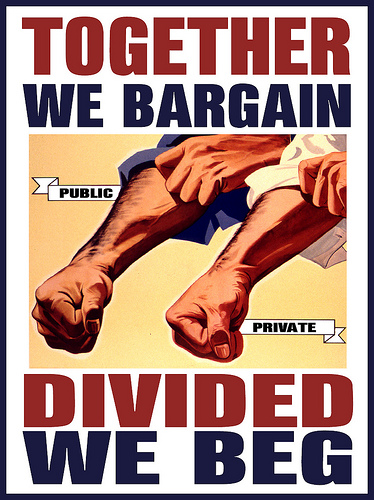Unions are typically responsible for collective bargaining but what if a workplace has yet to be unionized? Workers still can effectively negotiate with employers as long as they maintain solidarity throughout. An employer can’t risk all of her/his employees walking out at once or refusing certain tasks. Because of this workers can band together and make specific demands to improve the workplace. This guide will cover:
What collective bargaining is
How to decide demands
Marching on the boss
Harper’s impact
Collective bargaining
In 1948 the United Nations Universal Declaration of Human Rights enshrined the international right to participate in a union and collective bargaining. This was upheld by the Supreme Court of Canada in 2007 which observed that the process was essential to self-governance of workers and workplace democracy.
The process of collective bargaining begins with workers sharing their experiences with each other. When workers realize that common problems exist in the workplace, they can begin to organize to assert their rights and demands. Unionizing is often a long process as many companies resist or try to squash efforts. When workplaces have unions, it’s usually the union’s responsibility to speak on behalf of the workers and bring up issues to be discussed with the employer.
Deciding demands
Collective bargaining is all about coming to a collective agreement that appeases both workers and employers. Concerns can relate to workplace safety, wage scales, overtime or resolving grievances. Settling these issues results in the creation of an agreement or contract, which guarantees the rights of workers discussed through bargaining. Unions can use tools to bargain with employers such as strikes and pickets. Most employers, especially of large companies, are resistant to the demands of workers. These tools help unions fight on behalf of their workers for the inclusion of as many demands as possible in the collective agreement.
Marching on the boss
But what if you don’t have a union? You can still create union solidarity and collectively bargain. An organizer can be elected to speak on behalf of employees to the boss and perform union work. However, if a dire situation arises in an non-unionized workplace, more immediate action may be required. This can be accomplished by marching on the boss.
For example, a hard working senior employee may be threatened with being demoted from a supervisor position simply because an employer doesn’t want to continue to pay them a higher wage. The employer may feel as though they can still load extra responsibilities on the worker. Meanwhile, the decrease in pay would make it near impossible for the worker to pay her rent.
Other workers can march on the boss by assembling without warning and walking into the employer’s office to demand that the worker remain a supervisor. Don’t answer questions about how you found out about the worker’s situation. State your demand clearly and concisely. Outline your bargaining tool, which in this case might be an agreement between workers that no one will take on the work of a supervisor without being paid as one. Finally, make sure that all workers are prepared to follow through. Role playing the situation before hand can help workers prepare for the confrontation. Sometimes employers can be so caught off guard by union solidarity that they will give into your requests immediately.
The Harper government’s impact
Since coming to power, the Harper government has actively worked against unions. They have squashed the human right to collective bargain by denying Canada Post workers the chance to negotiate in 2011 by passing mandatory back to work legislation.




